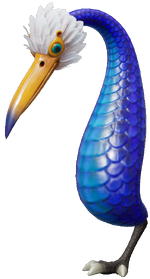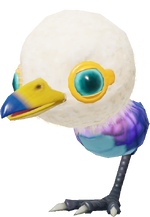Snavian family
The snavian family (ヘビドリ科?, lit.: "Snake bird family") is consisted of serpentine bird creatures that bury themselves underground and ambush surface dwelling prey. The Snavians, specifically Snagrets, are one of most diverse families after the grub-dog family, having adapted to numerous climates and environments across PNF-404.
They are found or referenced in all four Pikmin games, often constituting boss fights. In Pikmin, only Burrowing Snagrets appear, in The Forest of Hope and in Challenge Mode. In Pikmin 2, they appear in greater numbers and variety, particularly in the Snagret Hole. Finally, a Burrowing Snagret also appears in Pikmin 3 in Twilight River, and in Mission Mode.
Snagrets, which is the main type of enemy in this family, are in the Shiropedes genus. The family also consists of Burrowing Snarrows, but they are only mentioned and are part of an unconfirmed genus, possibly even the one same one as its Snagret counterparts.
Members[edit]
Burrowing Snagret[edit]
- Main article: Burrowing Snagret.
Scientific name: Shiropedes anacondii
The Burrowing Snagret is an enemy in the Pikmin games that hides underground, waiting to burst out when Pikmin approach. They are able to quickly snap up Pikmin on the ground with their beaks. Although the Snagret's whole body is vulnerable, it sustains most damage when its head is attacked. When killed, it explodes, yielding many Pellets in Pikmin, leaving only its head in Pikmin 2, and leaving the entire corpse (revealing it to have a single foot) in Pikmin 3. In the second game, they are smaller and have lower health, making them less of a threat, and in Pikmin 3, if they miss a peck, their beak gets stuck in the ground momentarily.
Pileated Snagret[edit]
- Main article: Pileated Snagret.
Scientific name: Shiropedes ambulatria
The Pileated Snagret is a larger, rarer, and more dangerous species of the Snavian family. It has a green, scaly body, and a bright orange head. It is called "pileated" because it has a crest of feathers on its head, and its eyes are decorated by some eyebrow-like features. The Pileated Snagret behaves much like the Burrowing Snagret, but it is able to completely emerge from the ground and hop around on one clawed foot. This means it can chase its prey, and makes its head harder to reach.
Downy Snagret[edit]
- Main article: Downy Snagret.
Scientific name: Shiropedes anacondii (fledgling)
The Downy Snagret is a young Burrowing Snagret, which hops around on land rather than burrowing. They sometimes spawn from eggs when broken.
Other members[edit]
Burrowing Snarrow[edit]
Official family unknown
This is a creature that was mentioned by Olimar in Pikmin[1], Pikmin 2[2], Pikmin 3 Deluxe, and Pikmin 4, but has not been seen in any game yet. It was recorded by Olimar to look almost exactly like a Burrowing Snagret, however it can be told apart by the presence of wing and tail markings when it is pulled from the ground, which the Burrowing Snagret lacks, as well as the Snagret having a blue feather hue that the Snarrow does not. Even though its family is unknown, its relation to the other members of the Snavian family make it likely that that is its classification.
| Language | Name | Meaning | Notes |
|---|---|---|---|
| ヘビガモメ? Hebi Gamome |
Snake Gull | ||
(traditional) |
蛇鱗鷗 | ||
| Schnipper | A play on "Gemeiner Schnapper" (Burrowing Snagret) | ||
| 뱀갈매기 | |||
| Pardauri-buraqueiro | Holemaker-snarrow | "Pardauri" comes from "pardal" (Sparrow); A play on "Corvuri-buraqueiro" (Burrowing Snagret) | |
| Tarugote escurridizo | From "Tagarote escurridizo" (Burrowing Snagret) and "tarugo" (dumb) |
Naming[edit]
"Snavian" is a portmanteau of "snake" and "avian", given their snake-like bodies and bird heads. All known members of this family use the word "Snagret" in their name, which seems to be a combination of the words "snake" or "snag", which means "to catch", and "egret", a kind of bird resembling the Snagrets. Their Japanese names also use the words ヘビガラス?, meaning "snake crow"; this is because of the enemies themselves being a combination of a snake and a bird – likely a crow.
The genus Shiropedes comes from 白?, meaning white in Japanese and pedes, meaning foot in Latin; these originate from the Burrowing Snagret's Japanese name オジロヘビガラス?, which means "White-tailed snake crow".
Names in other languages[edit]
| Language | Name | Meaning | Notes |
|---|---|---|---|
| ヘビドリ科? Hebi dori ka |
Snake bird family | ||
(traditional) |
蛇雞科 Shé jī kē |
Snake fowl family | |
(simplified) |
蛇雞科 Shé jī kē |
Snake fowl family | |
| snabreks | Snagrets | ||
| Ornipenten | Ornipents | Portmanteau of "orni" (Latin prefix for bird related things) and "serpente" (Latin for snake) | |
| Serpelli | Serpirds | From "serpente" (snake) and "uccelli" (birds) | |
| 뱀새 과 Baemsae Gwa |
Snake bird family | ||
| Gaviofídeos | Portmanteau of "gavião" (hawk), "ofídio" (Ophidian) and the suffix "-ídeos" (-idae), which is used for naming animal family names | ||
| Avirpéntidos | Portmanteau of "ave" (bird), "serpentino" (serpentine) and the suffix "-idos" (-idae), which is used for naming animal family names |
References[edit]
- ^ “The bluish hue of its feathers distinguishes it from the burrowing snarrow.” – Captain Olimar in the enemy reel entry on the Burrowing Snagret
- ^ “The majority of snagret species lie in wait to ambush and capture prey, with a body type perfectly adapted to such sudden strikes. It violently attacks small, surface-dwelling insects. Distributed across a relatively wide range, subspecies of snagret suited to the varying soil conditions have emerged, making the snagret the most geographically represented species besides the bulborb. Visually resembling the burrowing snagret is the burrowing snarrow, the range of which partially overlaps with the snagret's range. While the two may appear similar, when pulled from the ground they can be distinguished by the presence or absence of tail and wing markings.” – Captain Olimar in his notes on the Burrowing Snagret

